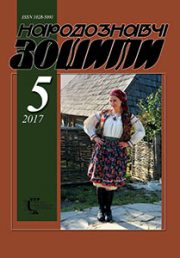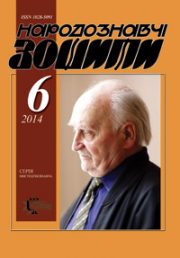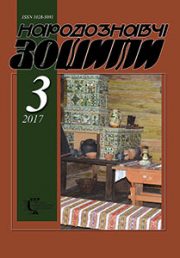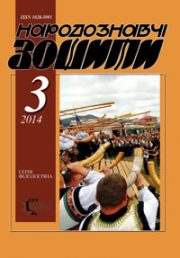The Ethnology Notebooks. 2024. № 2 (182), 410—422
UDK [728.81.035:726.8](477.84-21Бережани)
DOI https://doi.org/10.15407/nz2025.02.410
CHIKALO Yaryna
- ORCID ID: https://orcid.org/0009-0003-2280-2995
- Student of the Department of Architecture and Restoration,
- Institute of Architecture and Design
- National University «Lviv Polytechnic»,
- 12, S. Bandery St., 79013, Lviv, Ukraine,
- Contacts: e-mail: chiyarkaa@gmail.com
TARAS Yaroslav
- ORCID ID: https://orcid.org/0000-0001-7241-9466
- Doctor of Historical Sciences, Professor,
- Institute of Ethnology of the National Academy
- of Sciences of Ukraine,
- Head of the Modern Ethnology Department,
- 15, Svobody Avenue, 79000, Lviv, Ukraine;
- Lviv Polytechnic National University,
- Department of Architecture and Conservation,
- 12, Banderу street, 79013, Lviv, Ukraine,
- Contacts: e-mail: etnomod@ukr.net
Abstract. The preservation of Renaissance monuments in the lands of Galicia is an important and complex issue that requires a comprehensive scientific approach, including the availability of relevant theoretical developments that can form the source base for conducting proper conservation and restoration actions.
The aim of the article is to explore the history of the tombstone of Anna and Jerzy Sieniawski, specifically to identify the individual responsible for its creation.
The object of the study is the tombstone of Anna and Jerzy Sieniawski (particularly the figurative part of the latter) from the family crypt of the castle chapel in Berezhany (Ternopil region).
The subject of the study is the understanding of the features of the time, the synthesis of stylistic features of European schools, which determined the stylistics of the tombstone of Anna and Jerzy Sieniawski, and the attribution of the monument.
In 2023, one of the bas-reliefs from the tombstone composition of the noble family Anna and Jerzy Sieniawski, namely the sculptural depiction of the infant (Jerzy), was transferred to the Department of Architecture and Restoration at the Institute of Architecture and Design at the National University «Lviv Polytechnic» for research and restoration. Previously, the monument had been located in the chapel of Berezhany Castle in Ternopil region; it had been installed in the left part of the chapel, where burials had been conducted from the second half of the 16th century.
The methodological foundation of the research consists of the principles of historicism, sequence, scientific pluralism, systematics, and comprehensiveness. To determine the authorship of the tombstone, general methods were used: historical-comparative, historical-typological, and historical-systemic.
Keywords: Berezhany Castle, alabaster, Heinrich Horst, Herman van Gutte, Jerzy Sieniawski, Renaissance.
Received 23.04.2025
REFERENCES
- Lyubchenko, V.F. (1981). Lviv Sculpture of the 16th—17th Centuries — Lviv Sculpture of the Second Half of the 16th Century (Pp. 52—76). Kyiv: Naukova dumka [in Ukrainian].
- Lozynskyi, V. (1898). Lviv Art of the 16th—17th Centuries: Architecture and Sculpture (Pp. 107—171) [in Polish].
- Gebarovich, M. (1962). Studies in the History of Culture of the Late Renaissance in Poland (Pp. 30—64) [in Polish].
- Jan, K. Ostrovsky.(2012). Roman Catholic Churches and Monasteries of the Former Ruthenian Voivodeship (P. 99). Krakow [in Polish].
- Platform contributors, NewHomeStone, Tombstone History. Retrieved from: https://marbleism.com/blog/Tombstone_History.html.
- Contributors of the LiberText electronic library, Wooden sculpture of the Northern Renaissance. Retrieved from:
- https://batch.libretexts.org/print/url=https://human.libretexts.org/Bookshelves/Art/Art_History_(Boun dless)/20%3A_The_Northern_Renaissance/20.05%3A_Sculpture_of_the_Northern_Renaissance.pdf No. 20.5.1
- Contributor of Wikipedia. Ukrainian Wikipedia, Cornelis Floris. Retrieved from: https://uk.wikipedia.org/wiki/%D0%9A%D0%BE%D1%80%D0%BD%D0%B5%D0%BB%D1%96%D1%81_%D0%A4%D0%BB%D0%BE%D1%80%D1%96%D1%81_%D0%B4%D0%B5_%D0%92%D1%80%D1%96%D0%BD%D0%B4%D1%82 [in Ukrainian].
- Contributors of Wikipedia. Wikipedia, Renaissance Sculpture. Retrieved from: https://en.wikipedia.org/wiki/Renaissance_sculpture [in English].
- Contributor of the platform, «Osvita.ua». Renaissance: main ideas, fine arts, Italian representatives. Retrieved from: https://osvita.ua/vnz/reports/culture/10909/ [in Ukraini an].
- Antonovich, D.V. (1988). Ukrainian Culture-III. Renaissance (P. 303). Munich [in Ukrainian].
- Contributors of Wikipedia. Polish Wikipedia, Santi Gucci. Retrieved from: https://pl.wikipedia.org/wiki/Santi_Gucci [in Polish].
- Sinko, K. (1933). Santi Gucci Fiorentino and his school (P. 40). Krakow [in Polish].
- Macyszewski, M. (1910). Berezhany during the Polish Commonwealth: historical monograph (Pp. 79—192) [in Polish].







